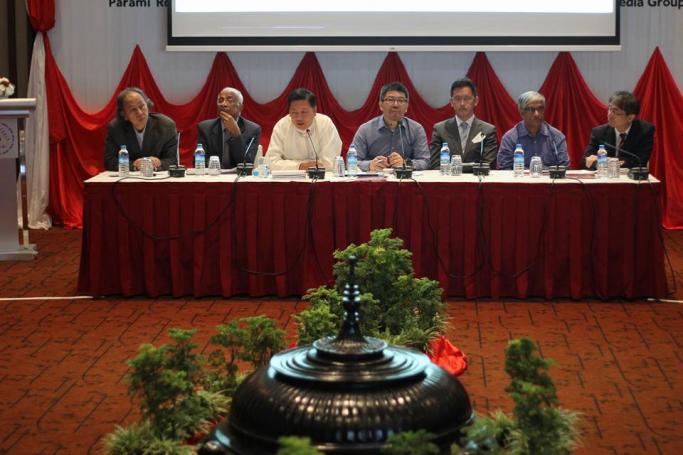Myanmar needs to engage more proactively with Bay of Bengal Initiative for Multi-Sectoral Technical and Economic Cooperation (BIMSTEC) grouping as it is strategically located as a gateway for Act East Policy of India as well as Look West perspective of Thailand.
This was the central message of the meeting of scholars and policy makers who assembled at the invitation of the Parami Round table on the occasion of 20th anniversary of BIMSTEC.
Scholars from India, Myanmar, and Japan attended and presented perspectives on how to ‘reinvigorate’ and ‘reactivate’ BIMSTEC so that the trade, investment and B2B exchange would benefit the over 2.5 billion population of the sub-region.
Identifying the strategic opportunity of the countries on the rim of the Bay of Bengal scholars pointed out the need for the more proactive engagement of the governments as well as strengthening the secretariat of BIMSTEC.
Chairing the panel discussion on this subject, Professor Lau Sim Yee of Reitaku University Japan pointed out that countries need to engage with regional groupings from a perspective of shaping the development discourse, particularly in relation to trade, investment and globalization. Myanmar thus needs to address some of the challenges from a perspective of its strength as a geographical entity and also its locational advantage.
Identifying the strategic opportunities for Myanmar, chief economist of the Parami Round Table Myo Thant pointed out that Myanmar needs to engage with all regional blocks as it is poised to take-off.
The concept of an “economic corridor” is important as ASEAN and the South Asia region collectively becomes a huge market with people having significant cultural affinities.
A transparent and inclusive approach for regional cooperation and providing space and scope for sub-national governments in the process of regional cooperation were identified as critical as Myanmar’s border regions and states have significant trade relations with countries like India and Thailand.
The need of the hour is going beyond connectivity projects and addressing soft issues like bottlenecks in trade, investment and people-to-people movement. The harmonization and ease of customs clearance, use of currencies, reducing transaction costs, integrating logistics are some of the initiatives that can enhance trade.
Vast Bay of Bengal coast becomes a critical asset for the BIMSTEC countries where historical maritime trade and commerce links have brought the countries together. The use of the Bay of Bengal as a public good for addressing transportation, climate change, fisheries and oil exploration could be some of the ideas that need to be pursued by the governments of the region.
Speaking on the occasion, former Indian Ambassador for Myanmar Mr V S Sheshadri pointed out that trade and investment cooperation from the countries of this region need proactive support from governments. Stagnat intra-BIMSTEC trade, that is hovering at around 5% - needs to be looked at and efforts towards developing FTAs between BIMSTEC countries can be one way to promote trade. Trade facilitation needs promotion from all the countries. Studies on value chain and supply chains need to be conducted in order to understand the dynamics of trade in the region.
Pointing out the reality that Myanmar’s democratization and openness is a tremendous opportunity,Mr.Kavi Chongkittavorn, editor of Myanmar Times stressed that the Bay of Bengal is a strategic asset for the countries of this sub region. The near normalization of Thai-Myanmar relations and the historical relationship between India and Myanmar provides a narrative of new and emerging geo-political configuration. It is in this context that BIMSTEC connectivity projects assume importance as this enables connecting asa Indo-China region with South Asia and Myanmar playinga critical role in this equation. Synchronizing BIMSTEC connectivity plans with ASEAN connectivity thus becomes important.
It has also been pointed out by scholars that BIMSTEC would also contribute in harnessing the opportunities of trade and investment in Africa with that of the ASEAN sub regional countries as well as South Asian countries.In this regard, the perspective of the Act East Policy, under the leadership of Prime Minister Narendra Modi of India was pointed out as an optimistic scenario for reinvigorating BIMSTEC.
Scholars from Japan and India pointed out the trade and investment opportunities, and the sectoral priorities as well as challenges and barriers for BIMSTEC countries and the role of governments.
It was pointed out that market relations, for example business to business engagements, will often compel governments to address some of the challenges and encourage them to undertake regional cooperation negotiations more seriously. Noting that Myanmar is not fully in the global value chain (GVC) regime of global trade, scholars pointed out the need to develop mechanisms for investment and trade expansion in the region.
Scholars who analysed the opportunities of Myanmar in BIMSTEC at the seminar included Prof. Thoshihiro Kudo and Dr Shinya Imaizumi from Japan and Prof. Ajitava Raychaudhuri, and Prof. Prabir De from India.
You are viewing the old site.
Please update your bookmark to https://eng.mizzima.com.
Mizzima Weekly Magazine Issue...
14 December 2023
Spring Revolution Daily News f...
13 December 2023
New UK Burma sanctions welcome...
13 December 2023
Spring Revolution Daily News f...
12 December 2023
Spring Revolution Daily News f...
11 December 2023
Spring Revolution Daily News f...
08 December 2023
Spring Revolution Daily News f...
07 December 2023
Diaspora journalists increasin...
07 December 2023
Leaders of NLD and USDP campaign rallies charged for breaking ‘Stay at Home’ order












